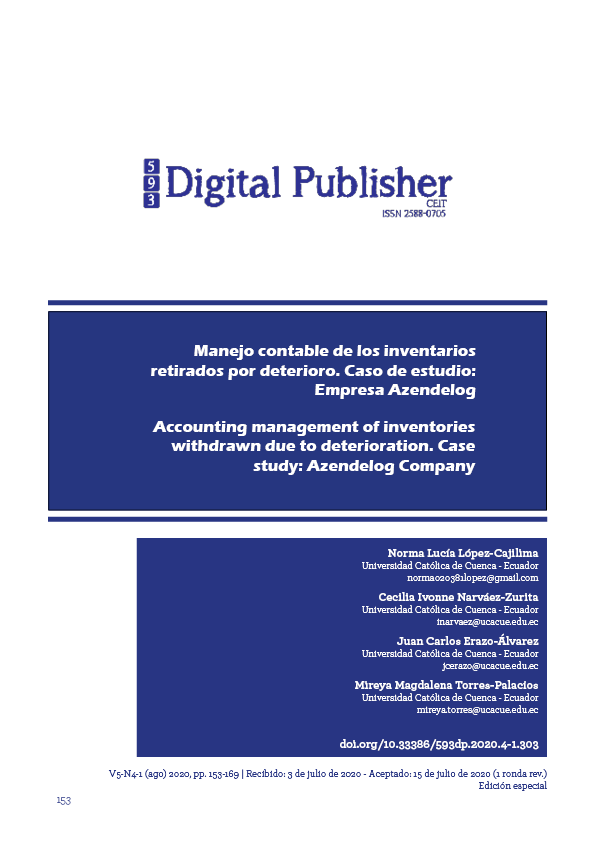Manejo contable de los inventarios retirados por deterioro. Caso de estudio: Empresa Azendelog
Contenido principal del artículo
Resumen
En la actualidad el crecimiento económico de las empresas y la competencia a nivel internacional, ha ocasionado la generación de estándares de acuerdo con las Normas Internacionales de Contabilidad, con el objetivo de presentar estados financieros equiparados a los de empresas internacionales, facilitando la interpretación de la información contable y la toma de decisiones financieras. Por este motivo las empresas necesitan que sus estados financieros se ajusten a la realidad y que sus registros contables se sustenten a través de normas legales vigentes. Uno de los problemas que presentan las empresas dedicadas a la comercialización de productos, donde el rubro más importante de los estados financieros corresponde a sus inventarios, es el control sobre los mismos así como el tratamiento contable cuando se presentan productos deteriorados, por esta razón el presente tema a tratar tiene como objetivo principal elaborar un procedimiento metodológico para la aplicación de la NIC 2 y determinar la existencia de deterioro así como su tratamiento contable respectivo. La metodología a seguir en esta investigación se sustenta en un diseño de tipo no experimental, el enfoque mixto cualitativo porque mediante las opiniones y experiencias se identificaron incertidumbres y cuantitativo, ya que a través de resultados obtenidos se aplicó un análisis al tratamiento contable de inventarios, estableciendo así un modelo sobre los procesos contables basados en NIC 2 y a través del cual la empresa puede considerar que la falta de control en los inventarios en cuanto a la caducidad, aplicación de costos por adquisición y sus gastos en ventas puede ocasionar un deterioro que afecta a los resultados finales de sus estados financieros y, por consiguiente, un impacto tributario.
Descargas
Detalles del artículo
1. Derechos de autor
Las obras que se publican en 593 Digital Publisher CEIT están sujetas a los siguientes términos:
1.1. 593 Digital Publisher CEIT, conserva los derechos patrimoniales (copyright) de las obras publicadas, favorece y permite la reutilización de las mismas bajo la licencia Licencia Creative Commons 4.0 de Reconocimiento-NoComercial-CompartirIgual 4.0, por lo cual se pueden copiar, usar, difundir, transmitir y exponer públicamente, siempre que:
1.1.a. Se cite la autoría y fuente original de su publicación (revista, editorial, URL).
1.1.b. No se usen para fines comerciales u onerosos.
1.1.c. Se mencione la existencia y especificaciones de esta licencia de uso.
Citas
Abad, J., Narváez, I., & Erazo, J. (2019). Gestión contable de propiedad, planta y equipo bajo las Normas Internacionales de Información Financiera (NIIF) para el sector funerario y de servicios exequiales. Visionario Digital, 3(1). doi:https://doi.org/10.33262/visionariodigital.v3i2.1..543
Alvarez, D., & Castro, K. (2016). Análisis del deterioro de valor de propiedad planta y equipo según sección 27 de la NIIF para PYMES en la industria textil caso: Zhiros Cía. Ltda. 57.
Bohórquez, N. (2015). Implementación de norma internacional de inventarios en Colombia. Innovar: Revista De Ciencias Administrativas Y Sociales, 25(57), 79-92. Obtenido de https://bit.ly/2zPn1BX
Bustos, C., & Chacón, G. (2012). Modelos determinísticos de inventarios para demanda independiente: Un estudio en Venezuela. Contaduría y administración, 57, 239-258.
Cando, J., Cunuhay, L., Toaquiza, S., & Tualombo, M. (2020). Impacto de las NIC y las NIIF en los Estados Financieros. Revista Científica FIPCAEC., 5(16). doi:https://doi.org/10.23857/fipcaec.v5i14.175
Chávez, G., Chávez, R., & Maza, J. (2020). Activos y pasivos por impuestos diferidos. NIC 12, un análisis desde Ecuador. Universidad y Sociedad, 452-457. Obtenido de https://bit.ly/2BxTXPE
Correa, C., & Gary, K. (noviembre de 2017). Valor Neto realizable de los Inventarios y su efecto en el costo de venta. Revista Observatorio de la Economía, 2. doi:ISSN: 1696-8352
Duran, C., Luz, E., & Parra, G. (2018). El distanciamiento entre el discurso teórico de la investigación universitaria y el discurso de la regulacioin contable en el contexto globlal. Actualidad Contable Faces, 21(36), 14-15. doi:E-ISSN 2244-8772
Durán, Y. (2012). Administración del inventario: elemento clave para la optimización de las utilidades en las empresas. Visión gerencial, 55-78. Obtenido de https://bit.ly/2ztMb8O
Fullana, C., & Paredes, J. (2008). Manual de contabilidad de costes. (F. M. Tomé, Ed.) Madrid, España : Delta publicaciones universitarias.
Garrido, I., & Cejas, M. (2017). La gestión de inventario como factor estratégico en la administración de empresas. Revista Científica Electrónica de Ciencias Gerenciales, 109-129. doi:E-ISSN: 1856-1810
Harol, E. (2019). Impacto Financiero de la aplicación de los métodos de valuación según NIC 2. Universidad Peruana Unión, escuela profesional de contabilidad, 1-12.
Hurtado, J., Ortiz, A., Barragán, A., & Gamboa, J. (2017). Propuesta de control interno a los inventarios basados en las Normas Internacionales de Contabilidad. Revista Publicando, 4(12), 573-591.
IASC –International Accounting Standards Committee. (2019). Norma Internacional de Contabilidad nº 12 Impuesto a las Ganancias. 442 - 505. Obtenido de https://www.ifrs.org/
IFRS Foundation. (2013). NIC 2 Inventarios. Obtenido de https://bit.ly/2U1ym8v
Jiménez, E. (2018). El marco conceptual del IASB y su contribución en la asimetría de información en el mercado crediticio. Revista Publicando, 5(15), 1279 - 1294. doi:ISSN 1390-9304
Juca, C., Narváez, C., Erazo, J., & Luna, K. (2019). Modelo de gestión y control de inventarios para la determinación de los niveles óptimos en la cadena de suministros de la Empresa Modesto Casajoana Cía. Ltda. (i. y. Centro del emprendimiento, Ed.) 593 Digital Publisher CEIT, 4(3).
López, D. (2012). Origen y Evolución NIC-NIIF.
Mena, R., Narváez, C., & Erazo, J. (2019). La planificación tributaria como herramienta financiera para la optimización de los recursos empresariales. Ciencia Digital Editorial, 3(2), 6-34. doi:DOI: https://doi.org/10.33262/visionariodigital.v3i2.1.540
Ortega, A., Padilla, S., Torres, J., & Ruz, A. (2017). Nivel de importancia del control interno de los inventarios dentro del marco conceptual de una empresa. Revistas Unisimon, 7(1). doi:ISSN:2463-0217.
Pastora, V., Armas, I., & Chasi, B. (2017). Los Inventarios y el costo de producción en las empresas industriales del Ecuador. Revista científico - educacional de la provincia Granma, 13(4).
Plúa, D., Loor, M., Zurita, F., Espinoza, P., & Pine, R. (2017). Los inventarios y sus efectos en la liquidez de las empresas comerciales. Contribuciones a la Economía. Obtenido de https://bit.ly/3cv0VSd
Reyes, M., Narváez, C., Andrade, R., & Erazo, J. (2019). Valoración contable de activos biológicos bajo NIIF en la empresa camaronera Biotónico S.A. Visionario Digital, 3(2.1). doi:https://doi.org/10.33262/visionariodigital.v3i2.1..585
Rivera, P., Darwin, V., & Barrionuevo, B. (marzo de 2017). Implementacion de las NIIF 16 "Propiedad planta y equipo"en el sector bancario de la ciudad de Guaranda. Revista Observatorio de la Economía, 8. Obtenido de https://bit.ly/2UtzcLC
Salas, K., Maiguel, H., & Acevedo, J. (2017). Metodología de Gestión de Inventarios para determinar los niveles de integración y colaboración en una cadena de suministro. Ingeniare. Revista chilena de ingeniería, 25(2), 326-337. doi:ISSN 0718-3305
Suárez, M. (2017). Tratamiento del inventario obsoleto según la nic 2 en la compañía Anp S.A. Universidad de Guayaquil. Obtenido de https://bit.ly/2Aq8Jrb
Tamayo, E., & Lopez, R. (2012). Contabilidad. Madrid: Editex.
Zapata, J. (2014). Fundamentos de la gestión de inventarios. Medellín, Colombia: Centro Editorial Esumer.





